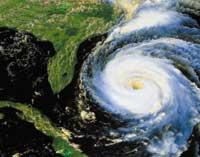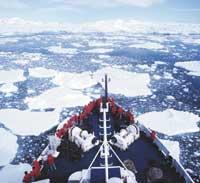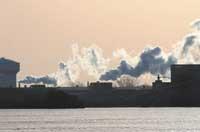Climate evolution

Few question that Earth's temperature is increasing as the greenhouse effect increases. However, it must be clear from the beginning that the greenhouse effect is a natural fact that allows the average temperature on Earth to be 15ºC and not -18ºC. The
Intergovernmental Panel of Experts on Climate Change (IPCC) has been collecting work and data from nearly 2,000 experts from around the world since 1988. The aim of the group is to show the relationship between greenhouse effect and temperature increase.
After ten years of work, IPCC scientists have drawn the following conclusions:
Since 1860, the average temperature of the Earth has increased between 0.4 and 0.6°C and, in addition, XX. In the twentieth century there has been the greatest warming of the northern hemisphere of the last 1,000 years. Thus, looking ahead, scientists are pessimistic: In 1995 it was indicated that by 2100 temperatures would increase among others 1-1.3 °C, although today this increase is estimated between 1.5-6ºC.
Slight balance of climate fluctuations
Thanks to the archive formed by ice and sediment, the history of the climate is well known and it is shown that since the emergence of life, the Earth has undergone cyclical climatic changes. Therefore, it practically gets in my power whether or not there is a position contrary to climate change. In short, life has always adapted to climate change, although for this it has had to pay the price of mass extinctions.

Glaciations and interglacial times correspond to the changes that the Earth's orbit has undergone in its trajectory around the Sun. The problem is that if we take care of these cyclical changes, after the present time the glaciation is expected and not the temperature increase shown by the data.
But when talking about climate change, in addition to the influence of the greenhouse effect on the increase in temperature, we must take into account the other phenomena that occur as a result of the change of composition of the atmosphere.
In fact, most experts agree that the system is currently totally unbalanced. Proof of this are the data that show that the breadth of the changes of the last century is far superior to that of the thousands of previous years. In the last 400,000 years, the concentration of carbon dioxide has always been lower than 280 ppm (parts per million). But XIX. Since the 20th century it has been growing continuously to reach 360 ppm. The concentration of methane, another greenhouse factor, has gone from 0.7 per million to 0.8 and the concentration of ozone in the northern hemisphere is four times higher.
Future scenario

IPCC experts believe that the average Earth temperature will increase by 2100. However, it is not yet possible to return to the climatological terms of this thermometer rise. Ignorance still predominates and, above all, it is about to define how fog and plants will affect.
Will two gradites be sufficient to endanger the future of the descendants? It is not easy to answer, but if we analyze the consequences of a 0.6°C increase measured in the last 30 years, the picture is black. Two major changes are mentioned, on the one hand, the reduction of ice and snow, and on the other, the heavy storms and unforeseen droughts that have caused serious catastrophes.
In the last 30 years, Arctic banquisa has decreased by 40% and in the last 150 years glaciers have lost an average of 30-40% of its surface and 50% of its volume. In this march, within a century, 95% of the glaciers of the Alps will disappear. In addition, although some Argentine glaciers continue to grow, at medium altitudes it is a widespread tendency to thaw from Mount Kenya to the central Asian mountain range of Tien Shan.
Of course, thawing represents an increase in sea level, mainly due to the thermal expansion that produces the heating (increasing the temperature of the water dilates). XX. In the 20th century, the average sea level has risen between 10 and 20 cm, 10 times faster than in the previous 3,000 years. By the coming century, on average, the seas can climb half a meter.
As for storms, they continue to recall, in America and Asia, in the years 1997-1998, the disaster caused by the Child and the storm that in December 1999 affected western Europe. In February 2000, southern Africa saw the biggest floods in the last 50 years and the Middle East saw drought and hunger.
Faced with these phenomena, some see the first signs of climate change. In the case of El Niño, meteorologists have highlighted their violence. By launching a large mass of water into the Pacific, a climate imbalance occurs every 2-7 years and the strength of the Child has been the highest in the last 80 years. In the case of the 1999 storm, experts highlight an exceptional journey, since instead of ending on the French coast, the country was strengthened during transit.

Rainfall has increased in the middle altitudes of the northern hemisphere and at high altitudes (0.5-1% in the last decade), while models show a predominance of climate contrasts.
Scientists, however, are cautious and do not want to establish cause-effect relationships between extreme episodes and possible climate change. Although there may be a relationship, we must not forget that the severity of the damage is intimately linked to the new occupation of the country, urbanization, land changes, and that we are weakened and dependent on the changes of nature.
Does man lift up stone?
Paradoxically, man is guilty of climate change and, at the same time, one of the most affected by the terrible consequences. With current knowledge, no one can draw the chart of the world of the future quite accurately, but thick brushstrokes can be made that predict the future of the human being in a dark way.
Rising sea levels directly threaten regions between 1 and 4 meters. In general, they are places where a high density population lives and where fertile land is usually available for agricultural activity. For example, half of Egypt's agricultural products are produced in the Nile River Delta, and if forecasts are met, it risks flooding unless huge walls are built throughout the environment.

Floods here, drying out there. It seems that there will be fewer and fewer places to live. In the intertropical regions, the decrease in rainfall is expected to increase, so desertification will accelerate. There are already 250 million people affected by desertification and another 750 million are in danger. The Sahara will slowly eat savannah, the fertile lands of the Middle East will become barren, the desert will spread from central Asia to the black lands of Volga and the northern tip of India. If all this happens, the conclusion is that the poorest countries with the most population will be directly affected and, faced with the greatest difficulties to live, will increase emigration and conflicts.
And all this is undoubtedly due to the industrial revolution and the spectacular demographic increase. The greenhouse effect caused by natural agents, solar change and volcanic eruption is much lower than that caused by human activity, and not only that, but in recent decades they have also been negative.
The dramatic increase in carbon dioxide in the atmosphere is considered the main responsible for heating. And, as is known, the increase in the concentration of this gas is due to the combustion caused by industrial and agricultural activities; on the one hand, to the combustion of coal and oil (in this way they emit 5-6 million tons of carbon per year) and on the other, to the wood. The latter's condition is still difficult to measure, since burning forests releases CO 2, but for vegetation to grow again part of CO 2 is consumed.
Industrialization of regions and intensive agriculture, along with destruction of vegetation, facilitates erosion and significantly alters the water cycle. Thus, climate changes occur in the regions and, as the global climate is formed by the sum and interaction of the regions, those that seem bites end up being complementary to the turbulent.

But how long will man hide his responsibilities after an indispensable evolution? It is true that the climate system is balanced early or late, but if adequate measures are not taken, will it not be too late? The demand for unified and fixed agreements is growing, but non-conformities are also gaining ground.
Is the agreement impossible?
Today, the signing of a global agreement to reduce the greenhouse effect is considered essential to improve the situation. The first steps to carry out this idea were taken in 1992 in Rio de Janeiro, but it seems that the initial will has been gradually lost.
At the place of this conference, the world appeared divided into two parts. On the one hand, the United States and the industrialized countries of Europe and on the other, the developing countries. However, although there are two main parts, three criteria were established. The first is from the United States. They are not too quick to question their models of development and energy. The second position would be that of the most industrialized European countries. These are great producers of pollution since the industrial revolution, but they have demonstrated a greater willingness to face the problem. The third point of view is that of developing countries. According to them, sacrificing their development for the pollution generated by others is too expensive.

However, despite major discrepancies, several documents were signed with political commitments. In addition, the list of countries that must make special force to protect the atmosphere was drafted. One of the next most important and decisive conferences on climate change was the one held in Kyoto in 1997. The Kyoto protocol was agreed at this conference.
With the signing of the Protocol 38 countries committed, between 2008-2012, to reduce by 5.2% the carbon dioxide emitted in 1990. The European Union must reduce by 8%, Japan by 6%, Russia must keep it and Australia and New Zealand are entitled to pollute more than so far! The United States, for its part, pledged to maintain the amount so far, even though George W. Bush.
In November 2000, the Hague conference sought to consolidate the implementation of the agreement in Kyoto. The defeat was total, because it is easier to sign the agreement than to launch it.
Discussions on the influence of forests and land use in the carbon cycle were officially blocked. We know that vegetation and oceans help regulate CO 2 emissions: of the 28 tonnes of CO 2 generated by human activities, both powerful natural pumps absorb half.
And as everything is negotiated, the United States proposes to reduce part of its volume of CO 2 emissions that is stored in its forests. But researchers say that the absorption capacity of forests varies depending on temperature. In high temperature areas, the vegetation deteriorates earlier, so more CO 2 is generated than that absorbed. Therefore, before deciding anything, we need to investigate the effects of forests.

The sixth climate conference was held in Bonn, Germany in May this year. G. US President Bush, days earlier, seriously criticized the Kyoto protocol and declared that he did not accept it. Therefore, the conference began without any motivation and not much progress was made on four major issues. The four areas to be negotiated were the implementation mechanisms of the Kyoto Protocol, the forest area, non-compliance penalties and economic and technical assistance to developing countries.
According to the most optimistic experts, the Bonn conference, although the level of commitments agreed in Kyoto declined, was positive. Faced with US criticism, the position of the rest of the countries was in danger. At last, although it cost, Japan opted for the Kyoto protocol. Developing countries also called for economic and technical assistance and demanded that the Kyoto protocol be respected. As a result, the European Union, Canada, Switzerland, Iceland, Norway and New Zealand pledged to provide annual aid of $410 million through 2005.
To launch the Kyoto protocol once and for all, the last annual conference was held in Marrakech. Representatives from the 180 countries started the Esperanzada summit, but the requirements of Japan, Canada and Russia, until the last hour, led them to not have an adequate solution. Finally, thanks to the EU proposal the agreement was reached and it seems that the Kyoto protocol will be launched next year.
However, we must not forget that the United States is currently the country that emits the most greenhouse gas emissions, among other things, 22% of carbon dioxide. If not maintained, they are expected to reach 34% by 2010.
With these events the atmosphere is very hot. There is intense debate among supporters and opponents and those who believe that the measures being taken are positive, and vice versa. See what steps will be agreed at the Rio 10 conference in South Africa next year.
Luis Balairon: “Energy consumption and population growth are the main problems”
Meteorologist Luis Balairon works at the National Meteorology Institute of Spain and has conducted and directed numerous studies on climate change. Among other things, he has participated in the research carried out for the United Nations and has coordinated the team dedicated to the research of the evolution of climate change in the Basque Country itself. He participated in the first day on climate change organized by the Physic Center.
Some consider that the temperature increase must be within the natural cycles of the climate and that, in addition, the Earth is able to adapt to this change. What do you think?

Earth is able to adapt to changes if given sufficient time. Forms of energy consumption and global population growth in developed countries have led to an increase in temperature in recent years. However, I am not too optimistic or pessimistic. If we look at an intermediate panorama, we can say that the temperature will rise between 2.5 °C and the sea level between 40 and 50 cm.
What will be the consequences?
In the case of water, although there are areas with higher rainfall, the availability of water is reduced. This is because, with the increase in temperature, evaporation will be more intense and therefore increase desertification. This will cause changes in the habitat of many animals and the evolution of species. Know the degree and adaptation of fauna and flora.
What is done to solve the problem?
In recent years a lot of work has been done on social awareness, and in that sense I am optimistic. There is also a general agreement. Kyoto is not the same, but it is important to start changing things because after some decisions come others. In Europe, for example, most energy companies have taken a serious part in the problem and participate in seminars and conferences. The gap between environmentalists and businessmen and politicians has been decreasing for years. Extreme ideas have lost strength and now we talk about what is happening.
What will be the next step in climate change research?
The next step in the study is to investigate in more detail the impact of climate change on ecosystems. Research to date has been conducted worldwide or in large regions such as the Mediterranean. From now on work should be limited to smaller scales.





